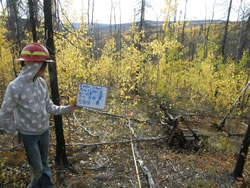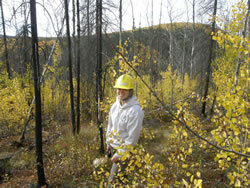National Cohesive Wildland Fire Management Strategy Success Story
Youth Study Succession after Fire and Flood
Yukon-Charley Rivers National Preserve, Alaska
Cohesive Strategy - Maintain and Restore Landscapes
2011

Youth study a plot to better understand fire and flood ecology. NPS Photo.

What re- growth! Trees are taller than the students. NPS Photo.
In early September, the Alaska National Park Service (NPS) Fire Ecology Program and Yukon-Charley Rivers National Preserve interpretive staff held the 7th annual field-based education program for Eagle Community youth. Twelve students ranging from 5th through 12th grade joined the fun. The Alaska NPS Wildland Fire Management Program established the education event in 2004 when Eagle was threatened by multiple wildfires. In the fall of 2004 after the wildfires were no longer a threat, NPS staff and Eagle students established, studied, and photographed fire effects plots in a variety of burned areas.
Following the rare and notable 2009 spring flood that inundated the community, Jennifer McMillan, Alaska NPS Assistant Regional Fire Ecologist, incorporated post-flood monitoring plots into the education program focused on youth involvement.
This year, students measured the post-fire and post-flood effects plots and discovered a rapid re-growth of young deciduous trees in both sets of plots. Sapling trees that were waist-high just a year or so ago now are taller than the students!
By studying vegetation re-growth after fire and flood, students learn that dramatic natural events do not necessarily have a negative effect on the important environment their community relies on for sustenance. For example, the ecology education program measures moose and other animal habitat use in flooded and burned areas.
This NPS field-based program continues to receive a warm reception from the Eagle community. It is an enjoyable and informative way for students to become more familiar with their surrounding ecosystem. For more information about this creative program, see Eagle Community School - Annual Ecology and Education Program and Eagle School Children & AK NPS Fire Management Track Forest Succession Following Intense Fire Season.
Contact
Jennifer Mitchell McMillan, Assistant Regional Fire Ecologist
Email: Jennifer_McMillan@nps.gov
Phone: (907) 455-0656
Keywords: Youth Involvement, Fire Ecology